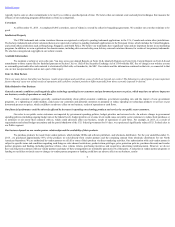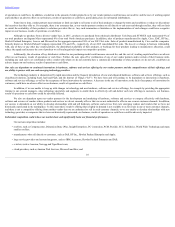CDW 2015 Annual Report Download - page 18
Download and view the complete annual report
Please find page 18 of the 2015 CDW annual report below. You can navigate through the pages in the report by either clicking on the pages listed below, or by using the keyword search tool below to find specific information within the annual report.
Table of Contents
Our ability to borrow under our Revolving Loan is also limited by a minimum liquidity condition, which provides that, if excess cash availability is less than the
lesser of (i) $125.0 million and (ii) the greater of (A) 10% of the borrowing base and (B) $100.0 million, the lenders are not required to lend any additional amounts under
our Revolving Loan unless the consolidated fixed charge coverage ratio (as defined in the credit agreement for our Revolving Loan) is at least 1.0 to 1.0. Moreover, our
Revolving Loan provides discretion to the agent bank acting on behalf of the lenders to impose additional availability reserves, which could materially impair the amount of
borrowings that would otherwise be available to us. We cannot assure you that the agent bank will not impose such reserves or, were it to do so, that the resulting impact of
this action would not materially and adversely impair our liquidity.
We will be required to generate sufficient cash to service our indebtedness and, if not successful, we may be forced to take other actions to satisfy our obligations under
our indebtedness.
Our ability to make scheduled payments on or to refinance our debt obligations depends on our financial and operating performance, which is subject to prevailing
economic and competitive conditions and to certain financial, business and other factors beyond our control. Our outstanding long-term debt will impose significant cash
interest payment obligations on us and, accordingly, we will have to generate significant cash flow from operating activities to fund our debt service obligations. We cannot
assure you that we will maintain a level of cash flows from operating activities sufficient to permit us to pay the principal, premium, if any, and interest on our indebtedness.
See “Management’s Discussion and Analysis of Financial Condition and Results of Operations-Liquidity and Capital Resources” included elsewhere in this report.
If our cash flows and capital resources are insufficient to fund our debt service obligations, we may be forced to reduce or delay capital expenditures, sell assets or
operations, seek additional debt or equity capital, restructure or refinance our indebtedness, or revise or delay our strategic plan. We cannot assure you that we would be able
to take any of these actions, that these actions would be successful and permit us to meet our scheduled debt service obligations or satisfy our capital requirements, or that
these actions would be permitted under the terms of our existing or future debt agreements, including our senior credit facilities and indentures. In the absence of such
operating results and resources, we could face substantial liquidity problems and might be required to dispose of material assets or operations to meet our debt service and
other obligations. Our senior credit facilities restrict our ability to dispose of assets and use the proceeds from the disposition. We may not be able to consummate those
dispositions or to obtain the proceeds which we could realize from them and these proceeds may not be adequate to meet any debt service obligations then due. Furthermore,
Madison Dearborn and Providence Equity have no obligation to provide us with debt or equity financing.
If we cannot make scheduled payments on our debt, we will be in default and, as a result:
• our debt holders could declare all outstanding principal and interest to be due and payable;
• the lenders under our senior credit facilities could foreclose against the assets securing the borrowings from them and the lenders under our Revolving Loan and
Kelway Credit Facility could terminate their commitments to lend us money; and
• we could be forced into bankruptcy or liquidation.
Despite our indebtedness levels, we and our subsidiaries may be able to incur substantially more debt, including secured debt. This could further increase the risks
associated with our leverage.
We and our subsidiaries may be able to incur substantial additional indebtedness in the future. The terms of our senior credit facilities and indentures do not fully
prohibit us or our subsidiaries from doing so. To the extent that we incur additional indebtedness or such other obligations, the risks associated with our substantial
indebtedness described above, including our possible inability to service our debt, will increase. As of December 31, 2015 , we had $843.1 million available for additional
borrowing under our Revolving Loan after taking into account borrowing base limitations (net of $2.1 million of issued and undrawn letters of credit and $439.6 million of
reserves related to our floorplan sub-facility) and an additional £ 50.0 million ( $73.7 million ) available under our Kelway Credit Facility.
Variable rate indebtedness subjects us to interest rate risk, which could cause our debt service obligations to increase significantly.
Certain of our borrowings, primarily borrowings under our senior credit facilities, are at variable rates of interest and expose us to interest rate risk. As of December
31, 2015 , we had $1,586.5 million of variable rate debt outstanding, $1,498.1 million of which is subject to a 1.0% LIBOR floor. If interest rates increase above 1% per
annum, our debt service obligations on the variable rate indebtedness would increase even though the amount borrowed remained the same, and our net income would
decrease. Although we have entered into interest rate cap agreements on our term loan facility to reduce interest rate volatility, we
17
























